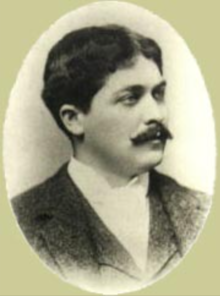Albert Cicero Schweinfurth | |
|---|---|
 | |
| Born | January 7, 1863 |
| Died | September 27, 1900 (aged 37) |
| Occupation | Architect |
| Relatives |
|
| Buildings | First Unitarian Church, Moody house, Hacienda del Pozo de Verona |
A. C. Schweinfurth (1864–1900), born Albert Cicero Schweinfurth, was an American architect.[1] He is associated with the First Bay Tradition, an architectural style from the period of the 1880s to early 1920s.[2]
Early life
Schweinfurth was the son of a German woodcarver who had immigrated to the United States a decade before his son Albert was born. His brothers Charles, Julius, and Henry also practiced in the architectural profession.
Career


Schweinfurth began his career in 1879. For the next decade he worked as a draftsman for various firms in Boston, Cleveland, New York, and Denver. In 1890, he moved to San Francisco and took a position as Chief Draftsman in the offices of A. Page Brown.[4]
In 1894, Schweinfurth established his own architectural practice under the patronage of William Randolf Hearst.[4] His Hacienda del Pozo de Verona (1894–1898), built for Phoebe Apperson Hearst in Pleasanton, was one of the first American buildings to incorporate features of Pueblo Revival architecture.[4][5]
Schweinfurth also designed the First Unitarian Church, a "landmark in the history of Bay Area architecture"[6] (1898), on the University of California, Berkeley campus.[7]
Schweinfurth designed the Dutch house Weltevreden located at 1755 Le Roy Avenue, Berkeley, California, also known as Moody House and later as Tellefsen Hall.[8]
Death
In 1898, Schweinfurth embarked on a two-year tour of Italy and France with his wife, Fanny, and their seven-year-old daughter.[7] Shortly after returning to the United States, he suffered an attack of typhoid fever. He died on September 27, 1900, in Dryden, N.Y.[9][10]
References
- ^ "A. C. Schweinfurth". Great Buildings. Berkeley, California. 1898. Retrieved 2023-06-24.
- ^ Brown, Mary (September 30, 2010). "San Francisco Modern Architecture and Landscape Design 1935–1970 Historic Context Statement" (PDF). California Office of Historic Preservation. p. 83. Retrieved 16 August 2011.
- ^ Betty Marvin (April 24, 1981). "National Register of Historic Places Inventory/Nomination: First Unitarian Church / 2401 Bancroft; University Dance Studio". National Park Service. and accompanying 10 photos from 1981 and a 1906 postcard
- ^ a b c Thompson, Daniella (May 21, 2009). "East Bay Then and Now: A Viennese Epicure in the Athens of the West". Berkeley Daily Planet. Berkeley, California. Retrieved 2015-08-23.
- ^ Canizaro, Vincent B. (2012-03-20). Architectural Regionalism: Collected Writings on Place, Identity, Modernity, and Tradition. Chronicle Books. p. 198. ISBN 9781616890803.
- ^ Gebhard and Winter, A Guide to Architecture in San Francisco and Northern California, Peregrine Smith Books, Salt Lake City, UT, 1985, p. 272
- ^ a b Thompson, Daniella (May 14, 2009). "East Bay, Then and Now: Schweinfurth's First Unitarian: A Powerhouse of a Church". Berkeley Daily Planet. Berkeley, California. Retrieved 2015-08-23.
- ^ Daniella Thompson. "Weltevreden". Berkely Landmarks. Berkeley, CA. Retrieved 24 June 2023.
- ^ Death notice. San Francisco Call, October 10, 1900, p. 11.
- ^ "Well-Known Architect Is Removed by Death". San Francisco Call, October 10, 1900, p. 12.
